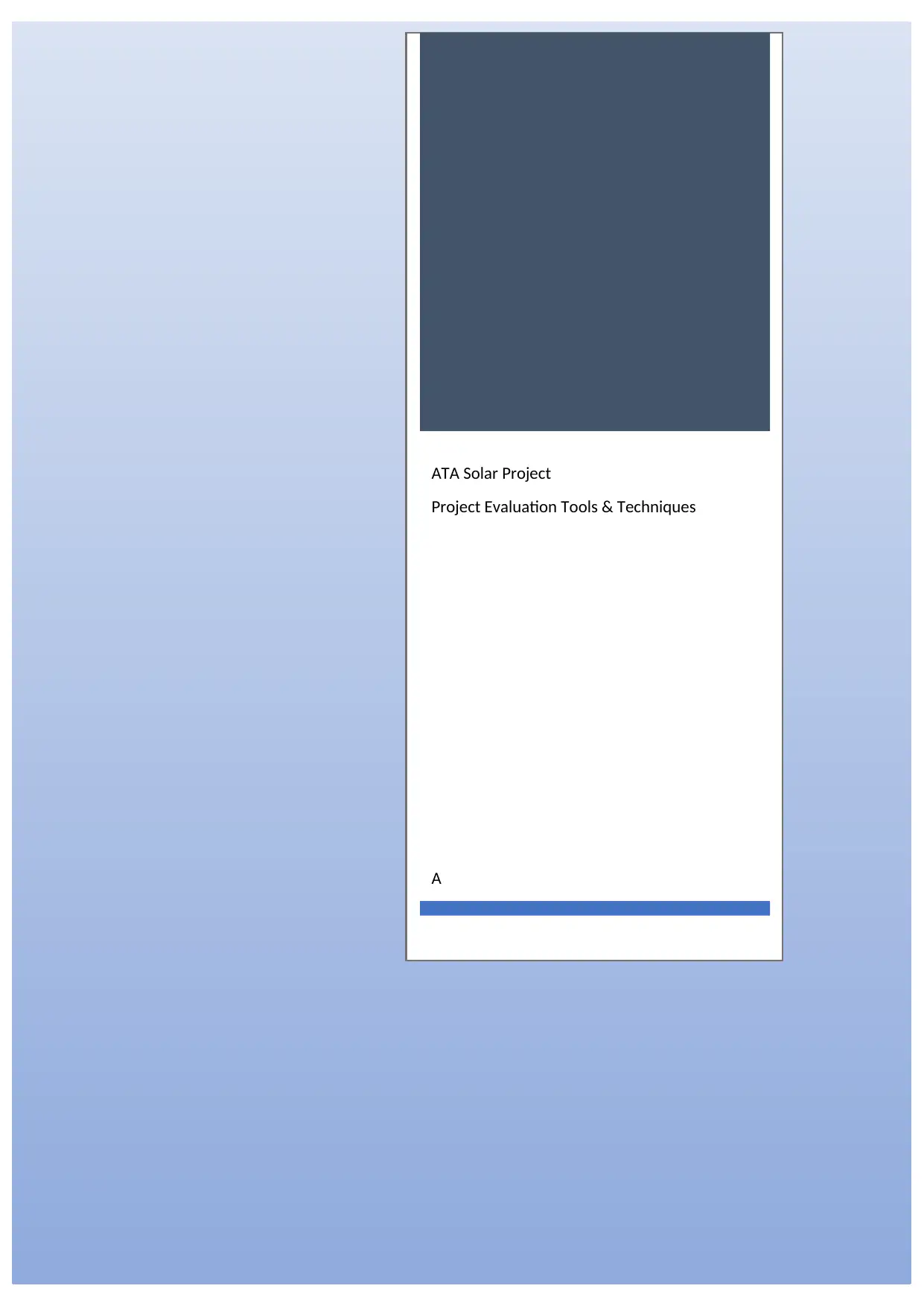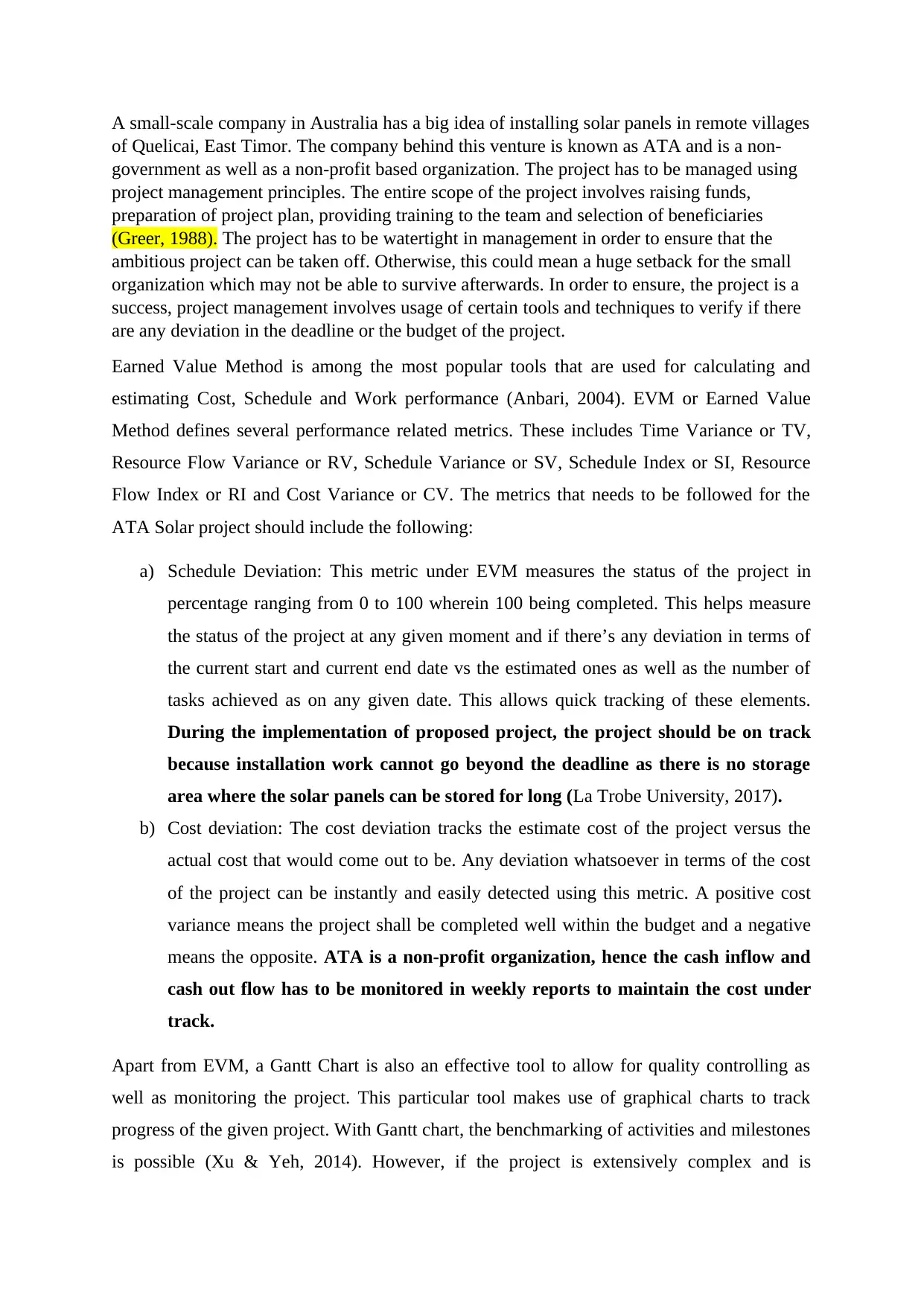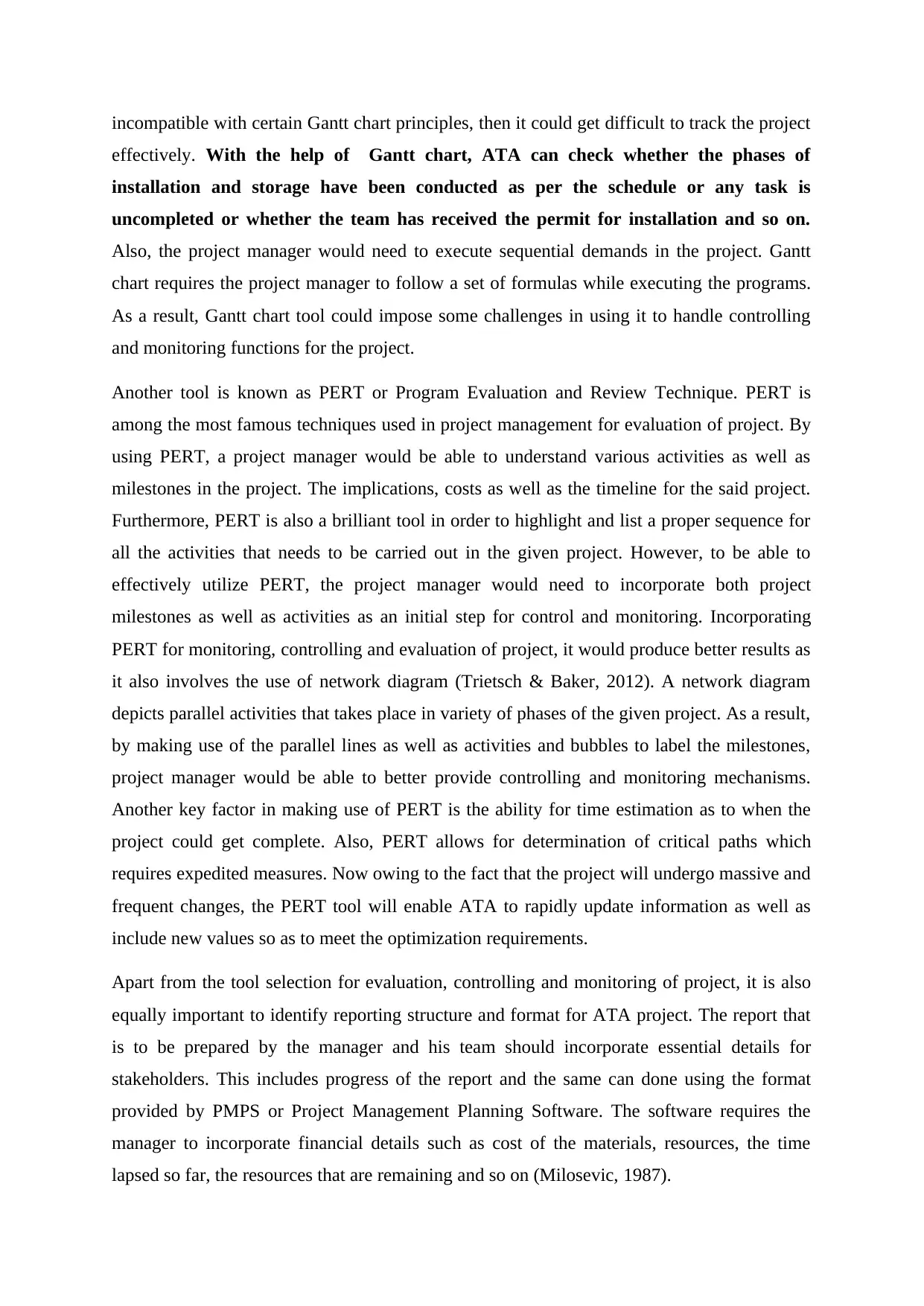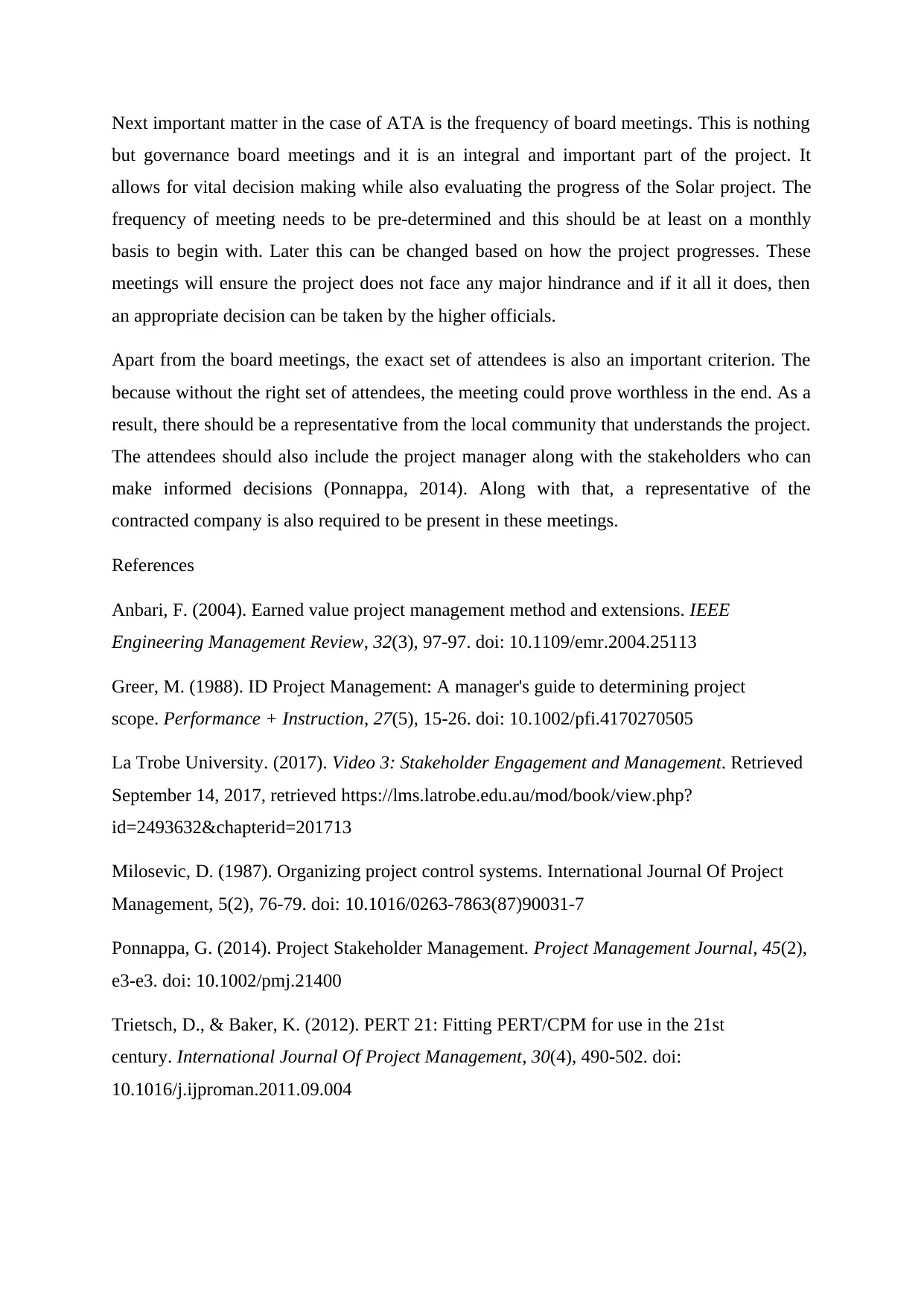ATA Solar Project: Applying Project Evaluation Tools & Techniques
VerifiedAdded on 2023/06/05
|6
|1510
|270
Report
AI Summary
This report evaluates the tools and techniques applied in the ATA Solar Project, a small-scale initiative by a non-profit organization to install solar panels in remote villages of East Timor. It emphasizes the importance of project management principles and the use of tools like Earned Value Method (EV...

ATA Solar Project
Project Evaluation Tools & Techniques
A
Project Evaluation Tools & Techniques
A
Paraphrase This Document
Need a fresh take? Get an instant paraphrase of this document with our AI Paraphraser


A small-scale company in Australia has a big idea of installing solar panels in remote villages
of Quelicai, East Timor. The company behind this venture is known as ATA and is a non-
government as well as a non-profit based organization. The project has to be managed using
project management principles. The entire scope of the project involves raising funds,
preparation of project plan, providing training to the team and selection of beneficiaries
(Greer, 1988). The project has to be watertight in management in order to ensure that the
ambitious project can be taken off. Otherwise, this could mean a huge setback for the small
organization which may not be able to survive afterwards. In order to ensure, the project is a
success, project management involves usage of certain tools and techniques to verify if there
are any deviation in the deadline or the budget of the project.
Earned Value Method is among the most popular tools that are used for calculating and
estimating Cost, Schedule and Work performance (Anbari, 2004). EVM or Earned Value
Method defines several performance related metrics. These includes Time Variance or TV,
Resource Flow Variance or RV, Schedule Variance or SV, Schedule Index or SI, Resource
Flow Index or RI and Cost Variance or CV. The metrics that needs to be followed for the
ATA Solar project should include the following:
a) Schedule Deviation: This metric under EVM measures the status of the project in
percentage ranging from 0 to 100 wherein 100 being completed. This helps measure
the status of the project at any given moment and if there’s any deviation in terms of
the current start and current end date vs the estimated ones as well as the number of
tasks achieved as on any given date. This allows quick tracking of these elements.
During the implementation of proposed project, the project should be on track
because installation work cannot go beyond the deadline as there is no storage
area where the solar panels can be stored for long (La Trobe University, 2017).
b) Cost deviation: The cost deviation tracks the estimate cost of the project versus the
actual cost that would come out to be. Any deviation whatsoever in terms of the cost
of the project can be instantly and easily detected using this metric. A positive cost
variance means the project shall be completed well within the budget and a negative
means the opposite. ATA is a non-profit organization, hence the cash inflow and
cash out flow has to be monitored in weekly reports to maintain the cost under
track.
Apart from EVM, a Gantt Chart is also an effective tool to allow for quality controlling as
well as monitoring the project. This particular tool makes use of graphical charts to track
progress of the given project. With Gantt chart, the benchmarking of activities and milestones
is possible (Xu & Yeh, 2014). However, if the project is extensively complex and is
of Quelicai, East Timor. The company behind this venture is known as ATA and is a non-
government as well as a non-profit based organization. The project has to be managed using
project management principles. The entire scope of the project involves raising funds,
preparation of project plan, providing training to the team and selection of beneficiaries
(Greer, 1988). The project has to be watertight in management in order to ensure that the
ambitious project can be taken off. Otherwise, this could mean a huge setback for the small
organization which may not be able to survive afterwards. In order to ensure, the project is a
success, project management involves usage of certain tools and techniques to verify if there
are any deviation in the deadline or the budget of the project.
Earned Value Method is among the most popular tools that are used for calculating and
estimating Cost, Schedule and Work performance (Anbari, 2004). EVM or Earned Value
Method defines several performance related metrics. These includes Time Variance or TV,
Resource Flow Variance or RV, Schedule Variance or SV, Schedule Index or SI, Resource
Flow Index or RI and Cost Variance or CV. The metrics that needs to be followed for the
ATA Solar project should include the following:
a) Schedule Deviation: This metric under EVM measures the status of the project in
percentage ranging from 0 to 100 wherein 100 being completed. This helps measure
the status of the project at any given moment and if there’s any deviation in terms of
the current start and current end date vs the estimated ones as well as the number of
tasks achieved as on any given date. This allows quick tracking of these elements.
During the implementation of proposed project, the project should be on track
because installation work cannot go beyond the deadline as there is no storage
area where the solar panels can be stored for long (La Trobe University, 2017).
b) Cost deviation: The cost deviation tracks the estimate cost of the project versus the
actual cost that would come out to be. Any deviation whatsoever in terms of the cost
of the project can be instantly and easily detected using this metric. A positive cost
variance means the project shall be completed well within the budget and a negative
means the opposite. ATA is a non-profit organization, hence the cash inflow and
cash out flow has to be monitored in weekly reports to maintain the cost under
track.
Apart from EVM, a Gantt Chart is also an effective tool to allow for quality controlling as
well as monitoring the project. This particular tool makes use of graphical charts to track
progress of the given project. With Gantt chart, the benchmarking of activities and milestones
is possible (Xu & Yeh, 2014). However, if the project is extensively complex and is
⊘ This is a preview!⊘
Do you want full access?
Subscribe today to unlock all pages.

Trusted by 1+ million students worldwide

incompatible with certain Gantt chart principles, then it could get difficult to track the project
effectively. With the help of Gantt chart, ATA can check whether the phases of
installation and storage have been conducted as per the schedule or any task is
uncompleted or whether the team has received the permit for installation and so on.
Also, the project manager would need to execute sequential demands in the project. Gantt
chart requires the project manager to follow a set of formulas while executing the programs.
As a result, Gantt chart tool could impose some challenges in using it to handle controlling
and monitoring functions for the project.
Another tool is known as PERT or Program Evaluation and Review Technique. PERT is
among the most famous techniques used in project management for evaluation of project. By
using PERT, a project manager would be able to understand various activities as well as
milestones in the project. The implications, costs as well as the timeline for the said project.
Furthermore, PERT is also a brilliant tool in order to highlight and list a proper sequence for
all the activities that needs to be carried out in the given project. However, to be able to
effectively utilize PERT, the project manager would need to incorporate both project
milestones as well as activities as an initial step for control and monitoring. Incorporating
PERT for monitoring, controlling and evaluation of project, it would produce better results as
it also involves the use of network diagram (Trietsch & Baker, 2012). A network diagram
depicts parallel activities that takes place in variety of phases of the given project. As a result,
by making use of the parallel lines as well as activities and bubbles to label the milestones,
project manager would be able to better provide controlling and monitoring mechanisms.
Another key factor in making use of PERT is the ability for time estimation as to when the
project could get complete. Also, PERT allows for determination of critical paths which
requires expedited measures. Now owing to the fact that the project will undergo massive and
frequent changes, the PERT tool will enable ATA to rapidly update information as well as
include new values so as to meet the optimization requirements.
Apart from the tool selection for evaluation, controlling and monitoring of project, it is also
equally important to identify reporting structure and format for ATA project. The report that
is to be prepared by the manager and his team should incorporate essential details for
stakeholders. This includes progress of the report and the same can done using the format
provided by PMPS or Project Management Planning Software. The software requires the
manager to incorporate financial details such as cost of the materials, resources, the time
lapsed so far, the resources that are remaining and so on (Milosevic, 1987).
effectively. With the help of Gantt chart, ATA can check whether the phases of
installation and storage have been conducted as per the schedule or any task is
uncompleted or whether the team has received the permit for installation and so on.
Also, the project manager would need to execute sequential demands in the project. Gantt
chart requires the project manager to follow a set of formulas while executing the programs.
As a result, Gantt chart tool could impose some challenges in using it to handle controlling
and monitoring functions for the project.
Another tool is known as PERT or Program Evaluation and Review Technique. PERT is
among the most famous techniques used in project management for evaluation of project. By
using PERT, a project manager would be able to understand various activities as well as
milestones in the project. The implications, costs as well as the timeline for the said project.
Furthermore, PERT is also a brilliant tool in order to highlight and list a proper sequence for
all the activities that needs to be carried out in the given project. However, to be able to
effectively utilize PERT, the project manager would need to incorporate both project
milestones as well as activities as an initial step for control and monitoring. Incorporating
PERT for monitoring, controlling and evaluation of project, it would produce better results as
it also involves the use of network diagram (Trietsch & Baker, 2012). A network diagram
depicts parallel activities that takes place in variety of phases of the given project. As a result,
by making use of the parallel lines as well as activities and bubbles to label the milestones,
project manager would be able to better provide controlling and monitoring mechanisms.
Another key factor in making use of PERT is the ability for time estimation as to when the
project could get complete. Also, PERT allows for determination of critical paths which
requires expedited measures. Now owing to the fact that the project will undergo massive and
frequent changes, the PERT tool will enable ATA to rapidly update information as well as
include new values so as to meet the optimization requirements.
Apart from the tool selection for evaluation, controlling and monitoring of project, it is also
equally important to identify reporting structure and format for ATA project. The report that
is to be prepared by the manager and his team should incorporate essential details for
stakeholders. This includes progress of the report and the same can done using the format
provided by PMPS or Project Management Planning Software. The software requires the
manager to incorporate financial details such as cost of the materials, resources, the time
lapsed so far, the resources that are remaining and so on (Milosevic, 1987).
Paraphrase This Document
Need a fresh take? Get an instant paraphrase of this document with our AI Paraphraser

Next important matter in the case of ATA is the frequency of board meetings. This is nothing
but governance board meetings and it is an integral and important part of the project. It
allows for vital decision making while also evaluating the progress of the Solar project. The
frequency of meeting needs to be pre-determined and this should be at least on a monthly
basis to begin with. Later this can be changed based on how the project progresses. These
meetings will ensure the project does not face any major hindrance and if it all it does, then
an appropriate decision can be taken by the higher officials.
Apart from the board meetings, the exact set of attendees is also an important criterion. The
because without the right set of attendees, the meeting could prove worthless in the end. As a
result, there should be a representative from the local community that understands the project.
The attendees should also include the project manager along with the stakeholders who can
make informed decisions (Ponnappa, 2014). Along with that, a representative of the
contracted company is also required to be present in these meetings.
References
Anbari, F. (2004). Earned value project management method and extensions. IEEE
Engineering Management Review, 32(3), 97-97. doi: 10.1109/emr.2004.25113
Greer, M. (1988). ID Project Management: A manager's guide to determining project
scope. Performance + Instruction, 27(5), 15-26. doi: 10.1002/pfi.4170270505
La Trobe University. (2017). Video 3: Stakeholder Engagement and Management. Retrieved
September 14, 2017, retrieved https://lms.latrobe.edu.au/mod/book/view.php?
id=2493632&chapterid=201713
Milosevic, D. (1987). Organizing project control systems. International Journal Of Project
Management, 5(2), 76-79. doi: 10.1016/0263-7863(87)90031-7
Ponnappa, G. (2014). Project Stakeholder Management. Project Management Journal, 45(2),
e3-e3. doi: 10.1002/pmj.21400
Trietsch, D., & Baker, K. (2012). PERT 21: Fitting PERT/CPM for use in the 21st
century. International Journal Of Project Management, 30(4), 490-502. doi:
10.1016/j.ijproman.2011.09.004
but governance board meetings and it is an integral and important part of the project. It
allows for vital decision making while also evaluating the progress of the Solar project. The
frequency of meeting needs to be pre-determined and this should be at least on a monthly
basis to begin with. Later this can be changed based on how the project progresses. These
meetings will ensure the project does not face any major hindrance and if it all it does, then
an appropriate decision can be taken by the higher officials.
Apart from the board meetings, the exact set of attendees is also an important criterion. The
because without the right set of attendees, the meeting could prove worthless in the end. As a
result, there should be a representative from the local community that understands the project.
The attendees should also include the project manager along with the stakeholders who can
make informed decisions (Ponnappa, 2014). Along with that, a representative of the
contracted company is also required to be present in these meetings.
References
Anbari, F. (2004). Earned value project management method and extensions. IEEE
Engineering Management Review, 32(3), 97-97. doi: 10.1109/emr.2004.25113
Greer, M. (1988). ID Project Management: A manager's guide to determining project
scope. Performance + Instruction, 27(5), 15-26. doi: 10.1002/pfi.4170270505
La Trobe University. (2017). Video 3: Stakeholder Engagement and Management. Retrieved
September 14, 2017, retrieved https://lms.latrobe.edu.au/mod/book/view.php?
id=2493632&chapterid=201713
Milosevic, D. (1987). Organizing project control systems. International Journal Of Project
Management, 5(2), 76-79. doi: 10.1016/0263-7863(87)90031-7
Ponnappa, G. (2014). Project Stakeholder Management. Project Management Journal, 45(2),
e3-e3. doi: 10.1002/pmj.21400
Trietsch, D., & Baker, K. (2012). PERT 21: Fitting PERT/CPM for use in the 21st
century. International Journal Of Project Management, 30(4), 490-502. doi:
10.1016/j.ijproman.2011.09.004

Xu, Y., & Yeh, C. (2014). A performance-based approach to project assignment and
performance evaluation. International Journal Of Project Management, 32(2), 218-228. doi:
10.1016/j.ijproman.2013.04.006
performance evaluation. International Journal Of Project Management, 32(2), 218-228. doi:
10.1016/j.ijproman.2013.04.006
⊘ This is a preview!⊘
Do you want full access?
Subscribe today to unlock all pages.

Trusted by 1+ million students worldwide
1 out of 6
Related Documents
Your All-in-One AI-Powered Toolkit for Academic Success.
+13062052269
info@desklib.com
Available 24*7 on WhatsApp / Email
![[object Object]](/_next/static/media/star-bottom.7253800d.svg)
Unlock your academic potential
© 2024 | Zucol Services PVT LTD | All rights reserved.



